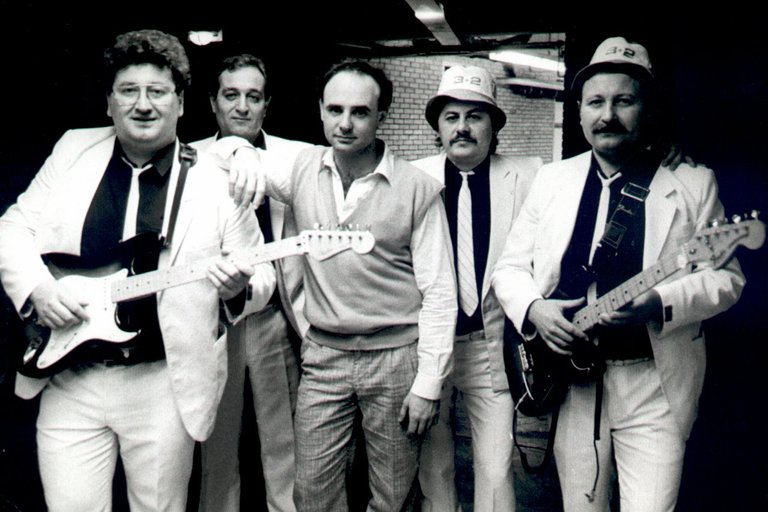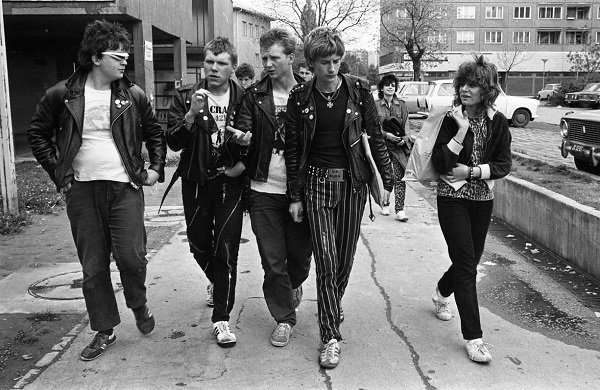Monday Music - Horrible Music From Hungary: Dáridó or Wedding Rock
Due to the raging success of my last Monday Music post on Mexican Banda music I decided to take a different direction in this series. So far I've focused on music that I actually enjoy listening to. I mean, what else would I write about? Well, how about the tunes I find most annoying? Crazy as it sounds, there are actually people who may be into them. After all, we're talking about hugely popular music here. And quite frankly, if someone tells me about some music that's so bad it's almost good, I'm certain to at least give it a chance. I guess I'm just weird like that...
The Phenomenon of Dáridó or Wedding Rock
Back in the early 80's, when I was a little ankle-biter in a remote little Hungarian village close to the Romanian border, I remember an interesting thing occurring in the evenings outside the town's only movie theater. Once the feature film was finished and the audience had left the building, they tended to stay a bit longer, loitering around the place, and listening to a particular music blasting from portable tape players. While it sounded modern, with electric guitars and synthesizers, the tunes had a very familiar sound to them. They were either traditional old folk songs, or at least songs that followed the same pattern of style. And those fans, mostly teenagers with the typical mullets, jeans jackets, and little 50cc motorbikes, just went literally crazy to this music! (Note: I'm not sure how much these guys in this image were into dáridó, but at least their outfit is spot on.)
My other memory that sticks out from back then, is how my parents, and other adults of their generation, reacted to this music: with utter disgust! (Note, they may have been in their 30's themselves, so still way too young to complain about "these young people today".) What they seemed to mind mostly, was that traditional Hungarian music didn't feature guitars, especially electric ones, let alone synthesizers and saxophones. My never expressed counterargument was that traditional folk songs never got people dancing and jumping around crazily like those kids outside of the cinema, except for at weddings, of course. I didn't even know how close I got to the main point with that. But it makes sense: weddings are the occasions when young people take things into their own hands, especially the style of music.
Avoiding Censorship 1980's Style
Reading up on the history of Hungarian Wedding Rock I realized that it was quite significant in a very important way. Back then, the socialist regime censored everything recorded and intended for mass production, and when the first artist tried to bring out dáridó music, the censors threw it out immediately. Not because of any political statement (which there wasn't any anyhow), but for the same reasons my parents and their friends didn't like it: You just don't mix rock with traditional folk, period.
But by that time technology had advanced sufficiently to provide a nifty alternative: cassette tapes! So instead of going through the former channels, dáridó artists just recorded their demos on tape, and started selling them on the street. And people (like the mulleted teens outside our village cinema) would buy them, copy them, and keep spreading them.
Lagzi Lajcsi and 3+2
If I managed to perk your interest in Hungarian dáridó, I recommend you to check out these two artists. There are many more of course, but these are probably the most iconic ones. Lagzi Lajcsi, Galambos Lajos by real name, as his stage name could be translated as Wedding Louie, in fact became famous for not being famous. He was known for selling his tapes outside of the Sugár, the only major shopping center of Budapest at that time. Needless to say, the tapes sold like warm pastry, for obvious reasons: everyone knew the songs - most likely from numerous weddings - but combined with the modern style they enjoyed them even more. Today Lagzi Lajcsi is a highly successful recording artist, performer, producer, and host of music related TV programs.
The other group that made Wedding Rock a highly popular phenomenon in Hungary is called 3+2. The numbers symbolize the band members, the original three Bugyi brothers (the name means panties or knickers, so I should probably not even translate it), and the two members who joined later. I know, such incredible creativity! These guys managed to take this new musical style to the top. Their album Halvány őszirózsa (in English Pale Autumn Rose) sold 1.5 million times, and up to this day holds the Hungarian record of albums sold.
However, the song this group is most famous for, is called Csipkés kombiné. Since I've been already translating everything here, and mentioning ladies undergarments, the title of this song means something like Lacy Negligee. Right, I know! Just the subject matter recalls some bygone era (at least for those of us raised on hot-pants and bikini thongs), which in a way is an interesting symbolism for the music itself.
Dáridó in the Dicso too: MC Hawer & Tekknő
Fast forward a good 15 years to the late 90's when I got to be in the age of the aforementioned mulleted village youth. By then things had changed quite a bit in Hungary: the socialist system had been scraped, Western capitalism was unleashed on the country, and popular music was flooded by completely new styles. Hip-hop was all the rage at the time, and so was electronic music, commonly known as techno. However, wedding rock kept enjoying high popularity, as it always has.
It was then, that two resourceful musicians Koczka Géza and Benyó Miklós created the duo MC Hawer & Tekknő. The concept was pretty much the same as the trial-tested genre of wedding rock: take all your favorite wedding songs from the past, and perform them in the modern style. Except for this time instead of electric guitars they pimped the music with electronic beats, and interspersed it with humorous rap solos. Granted, the techno beats sounded like they came from a plastic can, and the rap was at the lowest level, but it didn't matter. Wedding techno got the attention of kids in baggy track suits, who probably blasted them outside village cinemas from portable CD players.
In any case, I wasn't there to witness it. For me it took another decade or so to get interested in this music, simply because it was so bad. In the end, I even started liking it... well, at least up to the point where I enjoyed the 1980's wedding rock. It was so bad, that it was almost good. So if you think you may want to try it, please feel free, and do it without any shame. Who knows, if you enjoy it you may be in for an interesting journey, as there are just sooooo many old Hungarian wedding songs, in all kinds of modern styles.
Take a Look at the Previous Posts in my Monday Music Series:
The Sound of the Hungarian Zither
Obligatory Line-Dance at Mexican Parties - El Payaso del Rodeo
Floating Into the Night by Julee Cruise
Classic Canadiana - Stan Rogers
Party Like There's No Tomorrow, Cry Like Everything Is Lost - Hungarian Gypsy Music
The Harder Sound of the Middle Ages - Corvus Corax
The First Hip-Hop I Actually Liked - Things Fall Apart by The Roots
No Prophets in Their Own Land - Rodrigo y Gabriela
Beyond the Boundries of Styles and Genres - King Gizzard and the Lizard Wizard
Accordion-Rock You May Not Know (But Really Should) - Los Tabascos
Songs of the Mexican Revolution - La Adelita
Memorable Weirdness - What Do You Want A Japanese To Do Again?
Gloomy Sunday - The Hungarian Suicide Song
Party Tunes from the Wild East - The "Russendisko" Experience
Folk Songs from Your Home Village - Hungarian Regional Sound Archives
Polynesian Salt Water Music
Images Conjured up by Tom Waits' Music
In Country: Folks Songs of Americans in the Vietnam War
Somebody Tell Me - Translating a Hungarian Song Into [EN] and [SP]
Somebody Tell Me - first trial & live performance [HU] [SP] [EN]
Horst Wessel in Mexico
Playing for Change - Old Favorites Played Around the World
Soothing Tunes and Gentle Rhythms of Mali Music
What Is It About Music? [Ecotrain's Question of the Week]
Halász Judit, Memories from my Childhood
Discovering Rocksteady
The New Generation of Banda


Great contribution to the community!!! ;-)
Hahaha, thank you. I hope at least the post is good, while the content matter is anything but...
Of course it is, don't understimate it! At least in my case, from Hungary I know only Bela Bartok, Zsuzsa Koncz, Kati Kovács and some gipsy tunes, not more... 😉
All right, you know Koncz Zsuzsa! Awesome! Bartók I'm not surprised, and Kovács Kati... the name rings a bell for me, but I can't place her.
Maybe Katis success was more in the GDR (where I lived) than in Hungary. In fact her biggest hit was in German. She was really awesome and although I was a kid I loved her... :-D
Wow, correction! I just read the Wikipedia and they say
Great to know!!!
You see, your post brought also this to the table! ;-)
@ylich I am sure that you heard about many more, like Liszt Ferenc, Kodály Zoltán, Ligeti György :-)
Hehehe, ok, ok! From your reminder, now I know that I am a little more educated than I thought...
Thank you for contributing to my self-esteem! 😂
You are welcome 😜
Do you want to get involved? Do you want to support music and this project? Follow us to keep you updated and read our Introduction post!